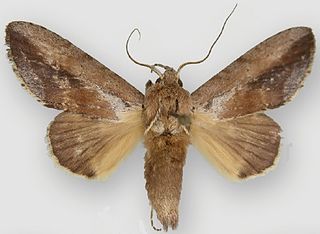Related Research Articles

Dodona dipoea, the lesser Punch, is a small but striking butterfly found in the Indomalayan realm that belongs to the Punches and Judies, that is, the family Riodinidae.

Hypolimnas misippus, the Danaid eggfly, mimic, or diadem, is a widespread species of nymphalid butterfly. It is well known for polymorphism and mimicry. Males are blackish with distinctive white spots that are fringed in blue. Females are in multiple forms that include male-like forms while others closely resemble the toxic butterflies Danaus chrysippus and Danaus plexippus. They are found across Africa, Asia, and Australia. In the new world they are found in the West Indies, with strays in Central and North America.

Battaristis concinusella is a species of moth in the family Gelechiidae. It is found in North America, including California, Delaware, Illinois, Maryland, Minnesota, North Dakota, Ohio, Ontario, Quebec, South Carolina and West Virginia.

Disphragis notabilis is a moth of the family Notodontidae first described by William Schaus in 1906. It is found throughout the Amazon basin from western Venezuela east- and southward to at least Bolivia. The range includes French Guiana.

Disphragis bifurcata is a moth in the family Notodontidae first described by J. Bolling Sullivan and Michael G. Pogue in 2014. It is found from Guatemala to Colombia, probably extending south into northern Ecuador. It is found at lower altitudes and moderate elevations up to about 1,000 meters.
Hypatima isotricha is a species of moth in the family Gelechiidae. It was described by Edward Meyrick in 1921. It is found on Java in Indonesia.
Sophronia sagittans is a moth of the family Gelechiidae. It was described by Edward Meyrick in 1923. It is found in Palestine.
Commatica pterygota is a moth in the family Gelechiidae. It was described by Edward Meyrick in 1929. It is found in Amazonas, Brazil.
Battaristis ardiophora is a moth of the family Gelechiidae. It was described by Edward Meyrick in 1914. It is found in Guyana, Brazil and Peru.
Battaristis cyclella is a moth of the family Gelechiidae. It was described by August Busck in 1903. It is found in North America, where it has been recorded from Arizona and Utah.
Compsolechia halmyra is a moth of the family Gelechiidae. It was described by Edward Meyrick in 1914. It is found in Guyana and Brazil.
Aristotelia squamigera is a moth of the family Gelechiidae. It was described by Walsingham in 1909. It is found in Mexico (Guerrero).
Thiotricha scioplecta is a moth of the family Gelechiidae. It was described by Edward Meyrick in 1918. It is found in Assam, India.
Thiotricha amphixysta is a moth of the family Gelechiidae. It was described by Edward Meyrick in 1929. It is found in Assam, India.
Thiotricha tethela is a moth of the family Gelechiidae. It was described by John David Bradley in 1961. It is found on Guadalcanal in the Solomon Islands.
Thiotricha embolarcha is a moth of the family Gelechiidae. It was described by Edward Meyrick in 1929. It is found on Java in Indonesia.
Antaeotricha colposaris is a moth of the family Depressariidae. It is found in Brazil (Amazonas).
Antaeotricha amphilyta is a moth of the family Depressariidae. It is found in the Guianas and Brazil.
Eclecta is a monotypic moth genus in the family Depressariidae. Its only species, Eclecta aurorella, has been found in the Australian state of New South Wales. Both the genus and species were first described by Edward Meyrick in 1883.
Imma euglypta is a moth in the family Immidae. It was described by Edward Meyrick in 1931. It is found in Colombia.
References
| This article on a moth of the subfamily Anomologinae is a stub. You can help Wikipedia by expanding it. |